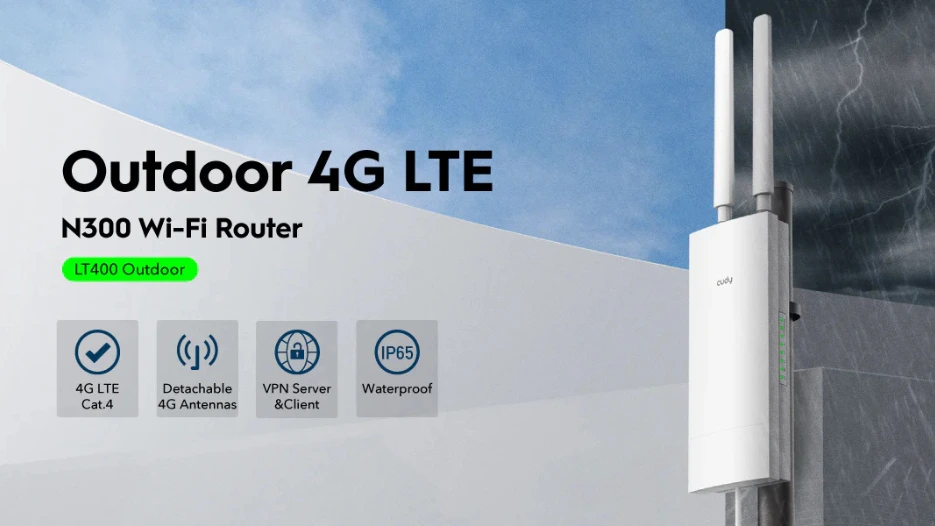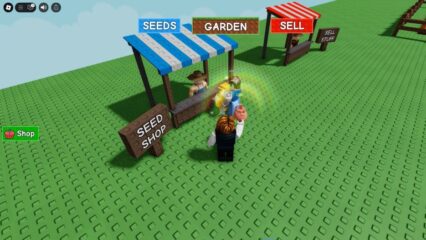If you’re living in an area where a wired broadband connection is unavailable or the existing broadband service isn’t good enough, the Cudy LT400 Outdoor 4G LTE router can be the solution for you. This router is designed to deliver reliable Wi-Fi connectivity over cellular networks by capturing mobile signals.
It can be useful for portable internet solutions, accessing the internet in rural areas, and as a backup internet option. After more than 6 months of use, we are sharing our experience with this router, including its strengths and weaknesses.
In This Article
Pros & Cons
Pros
Cons
Key Features of the Cudy LT400 Outdoor
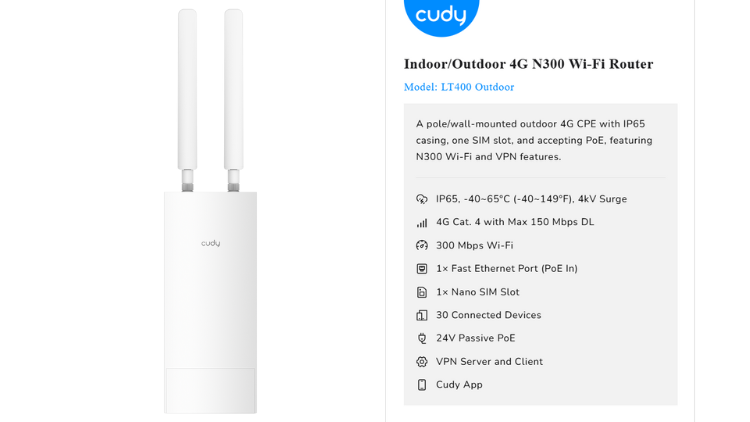
A pole/wall-mounted outdoor 4G CPE with IP65 casing, one SIM slot (Nano-SIM Slot), and accepting PoE, featuring N300 Wi-Fi and VPN features.
- IP65, -40~65°C (-40~149°F), 4kV Lightning/Surge Protection
- 4G Cat. 4 with Max 150 Mbps DL, Max 50 Mbps UL
- 300 Mbps Wi-Fi 2T2R (2×2 MIMO)
- 1× 10/100 Mbps Ethernet Port (PoE In)
- 1× Nano SIM Slot
- 2x Detachable Cellular Antennas
- 30 Connected Devices, Max Capacity 64
- 24V Passive PoE
- VPN Server and Client
- Range Performance: Max: 70 m (230 ft)
- Cellular Bands(US): LTE-FDD: B2/4/5/12/13/14/66/71, WCDMA: B2/4/5
- Cellular Bands(EU): LTE-FDD: B1/3/5/7/8/20/28, LTE-TDD: B38/40/41, WCDMA: B1/5/8
- Cudy App
- Certifications: FCC, CE
For more information about specs and software features, please visit the Cudy website.
Unboxing and What’s in the Box
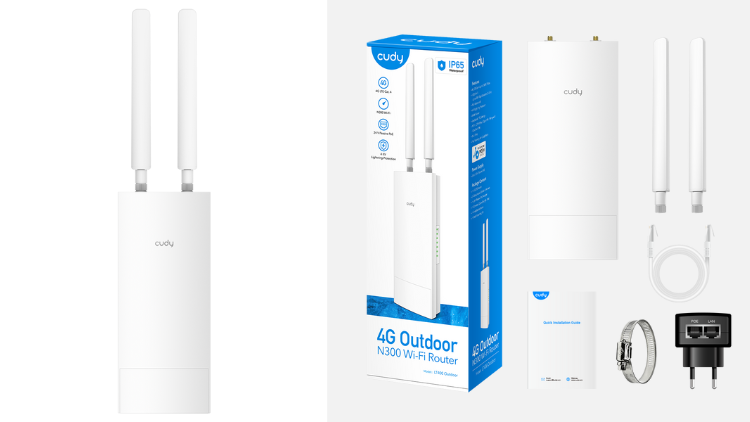
- 1x Cudy LT400 Outdoor Main Router
- 2x Detachable Antennas with SMA connector
- 1x PoE Adapter (24V 0.6A)
- 1x 1-meter Power Cord (Ethernet Cable)
- 1x Pole Mounting Clamp and Screws
- 1x Installation Guide
Design and Build Quality
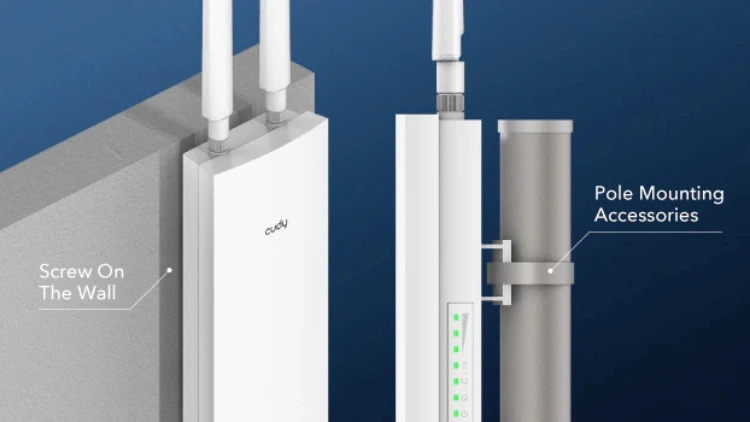
Physical Appearance
This router comes in only one color, white, with an IP65-rated casing, which is a very good feature, especially since it’s an outdoor router. When we first had the router in our hands, the in-hand feel was very good. It has a little matte finish over the ABS plastic material.
The antenna connector on the router was gold-plated and also rubber-capped. We also like its bottom shield design, especially a push lock SIM card slot that’s very practical for an outdoor router. The Ethernet cable quality was average, but everything else was just good.
Ports and Buttons
It has an RJ45 PoE port and a Nano SIM slot, plus a reset button located under the bottom shield. Also, the router has two SMA male antenna connectors on the top of the router.
Cudy LT400 Outdoor Router has a single PoE port for both powering and Ethernet connection. The SIM slot has a push-in locking feature just like legendary Nokia Feature Phones, so you can insert and remove a nano SIM very easily.
Indicators
It has a total of 7 LED indicators on it, including one for system status, one for internet connectivity status, one for LAN status, one for Wi-Fi status, and three for cellular signal strength indicators. These indicators can also be “turned off” from “Cudy-App” or “Cudy Web Interface”.
Antennas
This router comes with two detachable high-gain 4G antennas with SMA connectors, and there are also two additional WiFi antennas inside the router. Antenna quality is good, and Cudy says these two detachable antennas are as sensitive as a cellular mobile device.
We also found this quite relevant because it was able to catch cellular signals as well as a standard smartphone, and sometimes, it delivers better performance on the same network compared to smartphones.
Ventilation
Surprisingly, this router does not have a breathing vent. When we first got this router, we were a bit confused about how it can operate under extremely hot conditions, even if its internal circuits get hot.
So, we tested this router under direct sunlight with 10-15 connected devices, but this router remains the same in normal temperature and gets a little bit hot under +37°C direct sunlight. That is normal, I can say.
Adapter
This router comes with a standard 24V 0.6A PoE adapter. The Adapter’s build quality is decent and doesn’t get too hot during operation.
Setup and Configuration
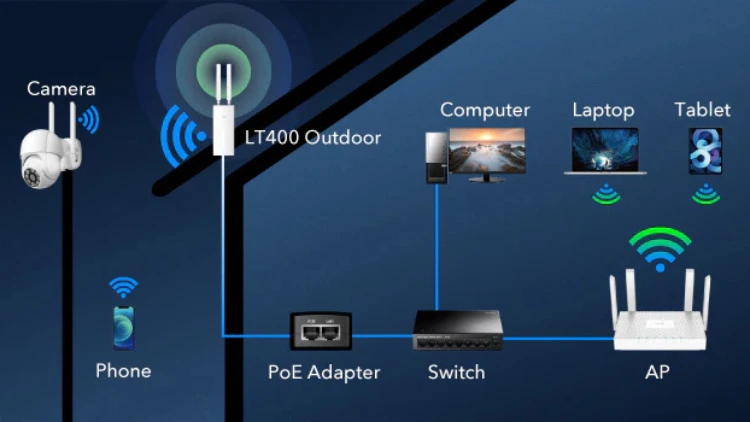
Initial Setup
First, connect two Antennas to the router and insert a Nano SIM card with a pre-purchased internet plan. Now, connect one end of the Ethernet cable to the router and the other end to the power adapter. The power adapter should be plugged into a power outlet with electricity.
As the router supports PoE, your router will be turned on, and the signal indicator will start blinking. The router should be placed in an area where mobile signals are good, or you can just place your router in outdoor mounting on a pole and power up with a long Ethernet cable that supports PoE (we used a 10-meter Cat. 7 RJ45 Ethernet cable).
The router is almost plug-and-play, and it requires 2-3 minutes to fully function and provide internet. Its three network indicators display the strength of the mobile signal reception. The two cellular antennas are omnidirectional and receive signals from all directions, so you don’t need to face them toward the cell tower.
That’s it. If your mobile operator doesn’t need an APN key, you can now enjoy WI-Fi with this router.
Web Interface/Mobile App
At first, the router does not have a password for the admin panel, so you need to set a new password for the first time. Connect any computer or mobile device to your router network, go to any browser, and type cudy.net or 192.168.10.1, where you will be asked to set a password.
Next, select the timezone, and also set the APN profile if your cell operator wants it, or you can just select “Auto” and click “Next”. Then you can set the SSID name, Encryption, and Password for your WiFi. That’s it! The basic router setup is now complete.
You can also do this with the “Cudy mobile app”, which you’ll find on the “Apple App Store” or “Google Play Store”.
Features and Performance
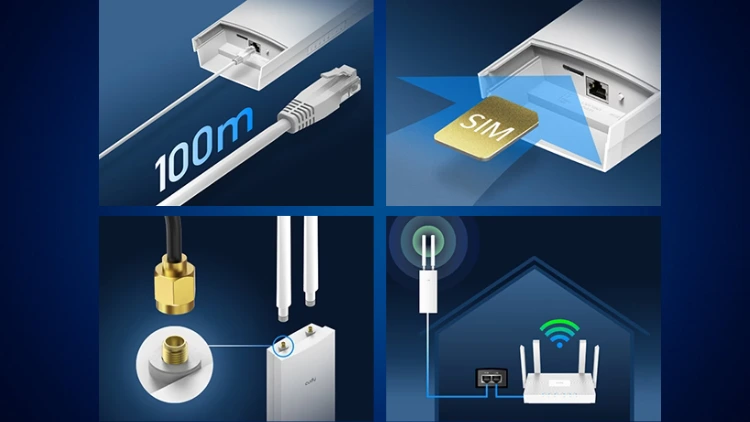
4G/LTE Performance
We installed the router outdoors on a pole, with the device positioned approximately 6 meters above the ground. In this condition, this router was able to catch full-bar 4G signals.
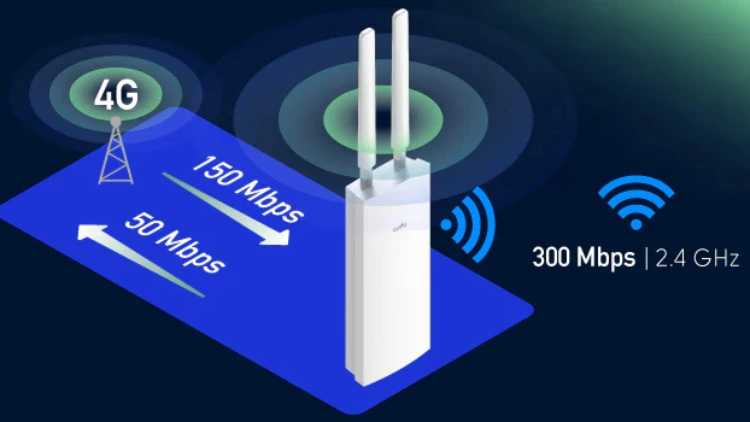
We observed very stable connections, free from any signal dropping or connection breaking. Cudy says this router antenna is as sensitive as a smartphone, and in our test, compared to a smartphone on the same 4G network, the signal reception quality was very good.
Wi-Fi Performance

We were able to achieve a stable internet connection at a distance of 50-60 meters in an outdoor environment with scattered trees around. The signal gets longer than this range, but after 60 meters, the internet gets slower.
As we live in a rural area where the cellular signal is weaker, we purchased a 15 Mbps internet package, and the router was able to deliver around 11-14 Mbps most of the time. On the same network, a smartphone was able to catch almost the same 10-13Mbps when the same SIM card was inserted in a mobile phone with the same internet package.
We were able to stream buffer-free YouTube, play online games like ‘WOT BLITZ,’ watch movies, and do our work smoothly with this router. The router never drops the internet and provides a very stable connection despite having a weaker 4G signal strength in our area.
We haven’t found any issues with slow internet, sudden connection loss, or any other problems. So, performance-wise, we found the Cudy LT400 Outdoor as good as a regular smartphone or better – I can say.
Ethernet Performance
Since the router only has a single PoE Ethernet port, you can use a single Ethernet connection by default from the adapter output. It’s a 10/100 Ethernet port, and with our internet connection speed, we can’t complain about it; it’s just good and works without any issues.
For indoor Wi-Fi use, we’re utilizing a secondary router (TP-LINK Archer C64) as an Access Point. It serves a TV, a desktop computer, and three smartphones, and we have experienced no problems; it also works fine.
Outdoor Performance
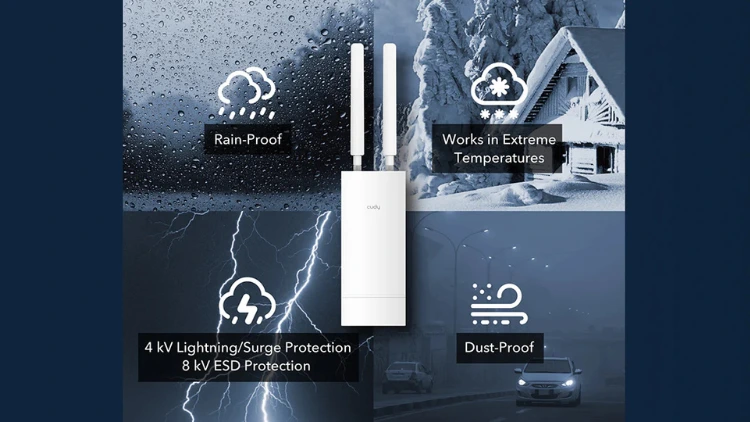
The router comes with an IP65-rated casing and built-in lightning/surge protection, which protects it from lightning strikes up to 4kV and provides 8kV ESD wind protection. Cudy says this router can operate in extreme temperatures as low as -20°C to as high as 60°C.
We have used this router outdoors for more than six months now, testing it in direct sunlight (up to 38°C), light and heavy rain, and during lightning and strong wind. We haven’t had any issues so far.
Additional Tips
Router Placement
For the best signal reception, place the router in an open outdoor area, such as on a pole, on a roof, or high ground. Avoid placing it near thick walls, metal structures, or large trees, as these can block the signal.
If you need indoor internet access, the outdoor router’s signal may be too weak. In this case, use a secondary router as an Access Point (AP), placing it indoors and connecting it to the Cudy LT400.
Features and Settings:
- Firmware: Keep your router’s firmware updated to ensure the best performance and security.
- Band Lock: Enable the band lock feature for a more stable and reliable connection.
- Data Limits: If you have a limited data plan, you can set a data limit through the router’s web interface. “Note that this feature is only available on the Cudy Web Interface.”
- VPNs: The router supports a limited number of VPNs. Before using one, check the router’s manual or website to confirm it is compatible.
Power and Compatibility:
- Power Outages: For uninterrupted service during power outages, consider using a backup power system like a mini home UPS or solar power.
- Carrier Compatibility: The router is compatible with most global carriers, but it’s always a good idea to confirm with your specific network provider.
Data Plans
This router is not compatible with internet plans that restrict hotspot or router usage. If your plan is not unlimited, be aware that data limits will apply.
